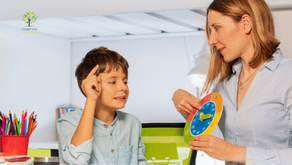Managing Anxiety: 8 Techniques for Supporting ASD Children
- ChildFirst Behavior Therapy
- Mar 19, 2024
- 6 min read

Autism Spectrum Disorder (ASD) is a neurodevelopmental condition characterized by challenges in social interaction, communication, and repetitive behaviors. One common co-occurring issue for many individuals with autism is anxiety. Managing anxiety in ASD children is crucial for their overall well-being and development. In this article, we will explore eight effective techniques to support and alleviate stress in children with Autism Spectrum Disorder.
Understanding Triggers
One of the first steps in managing anxiety in ASD children is to identify and understand their triggers. These triggers can vary widely from one child to another, but common ones include changes in routine, or social situations. Observing and keeping track of specific situations that lead to anxiety can help caregivers develop targeted strategies for support.
Overwhelming Environment:
ASD children may experience being overwhelmed in environments such as loud noises, bright lights, or certain textures, making specialized ABA therapy in Arlington Heights, IL, crucial. Understanding a child's specific needs can empower caregivers to create environments that are more accommodating and less overwhelming. This may involve providing noise-canceling headphones, using soft lighting, or offering autism-friendly materials.
Changes in Routine:
Many ASD children thrive on routine and predictability. Unexpected changes can lead to anxiety and distress. Caregivers should pay attention to situations where routine disruptions occur, whether it's a change in schedule, unexpected transitions, or alterations in familiar surroundings. Establishing a visual schedule and preparing the child in advance for any changes can be effective in minimizing anxiety related to disruptions in routine.
Structured Routine
ASD children often thrive in structured environments with predictable routines. Establishing a consistent daily schedule can provide a sense of stability, reducing anxiety associated with unexpected changes. Clearly communicate any variations in the routine in advance, allowing the child time to prepare for upcoming transitions mentally.
Establishing a Consistent Daily Schedule:
Creating a daily schedule with specific times for meals, activities, and rest helps provide a structured framework for ASD children. This predictability can be reassuring, as it gives the child a clear understanding of what to expect throughout the day.
Providing Visual Supports:
Visual supports, such as visual schedules or charts, can enhance the predictability of routines for ASD children. These tools use images or symbols to represent different activities and help the child understand the sequence of events. Visual supports serve as a tangible reference, aiding in smoother transitions between activities.
Preparing for Transitions:
Transitioning from one activity to another can be challenging for ASD children. To ease this process, provide warnings about upcoming changes in the routine. Using visual timers, verbal cues, or countdowns can signal the impending transition, allowing the child to prepare for the shift in activities mentally.

Clear Communication of Variations:
In situations where deviations from the routine are unavoidable, clear communication becomes crucial. Inform the child in advance about any changes and explain the reasons behind them. Providing a visual or written explanation can aid comprehension and minimize anxiety associated with unexpected alterations to the schedule.
Flexibility Within Structure:
While a structured routine is beneficial, it's essential to allow for some flexibility. Life inevitably includes unexpected events, and rigid adherence to a schedule may only sometimes be possible. Balancing structure with a degree of flexibility helps the child adapt to unforeseen changes while maintaining the overall stability of their routine.
Consistent Bedtime Routine:
Establishing a consistent bedtime routine is particularly important for ASD children. A predictable sequence of calming activities before bedtime, such as reading a story or listening to soothing music, can signal that it's time to wind down, promoting a more restful sleep.
Collaboration with Caregivers and Educators:
Maintaining a structured routine requires collaboration among caregivers, educators, and other individuals involved in the child's life. Consistent communication ensures that everyone is on the same page regarding the child's schedule, promoting a unified approach to support.
Visual Supports
Visual aids such as schedules, social stories, and visual cues can be powerful tools for ASD children. These visuals offer a tangible and concrete way to understand and anticipate activities or events, helping to reduce anxiety. Creating a visual schedule for the day or using visual cues during transitions can provide a sense of predictability.
Occasional Breaks
Many ASD children feel overwhelmed with their surroundings that can contribute to anxiety. Providing breaks, where the child can engage in activities that help regulate their surroundings, can be beneficial. This might include activities like deep pressure, fidget tools, or spending time in a quiet, dimly lit space.
Effective Communication
Establishing clear and straightforward communication is crucial when supporting ASD children. Use visual supports and simple language, and allow sufficient time for the child to process information. Providing choices and using positive reinforcement can enhance communication and foster a sense of control, reducing anxiety.
Social Skills Training
Anxiety in ASD children often stems from the unique challenges they face in social interactions. These challenges can lead to feelings of isolation, difficulty understanding social cues, and a general sense of unease in social settings. Addressing these concerns through targeted social skills training can be instrumental in empowering ASD children to navigate the complexities of social interactions more effectively.
Social skills training aims to equip ASD children with the tools they need to communicate more confidently and understand the subtle nuances of social cues. Effective communication is a crucial component, teaching them how to express themselves clearly and interpret the intentions of others. This not only fosters better connections with peers but also helps in building self-esteem.
Mindfulness and Relaxation Techniques
Teaching mindfulness and relaxation techniques can be beneficial for managing anxiety in ASD children. Simple practices such as deep breathing exercises, progressive muscle relaxation, or guided imagery can help children regulate their emotions and cope with stressful situations.
Collaboration with Professionals
Seeking guidance and support from professionals, including psychologists, occupational therapists, and particular education experts, can be instrumental in managing anxiety in ASD children. These professionals can provide personalized strategies and interventions based on the child's unique needs, fostering a comprehensive approach to support.

Conclusion
Managing anxiety in ASD children requires a holistic and individualized approach. By understanding triggers, establishing routines, incorporating visual supports, providing breaks, improving communication, offering social skills training, introducing mindfulness techniques, and collaborating with professionals, caregivers can create a supportive environment that enhances the well-being of ASD children and helps them navigate the challenges associated with anxiety. As each child is unique, a combination of these techniques tailored to the individual's needs can contribute to a more positive and anxiety-free experience for both the child and their caregivers.
If you are seeking professional guidance and support for your child, consider reaching out to our experts at ChildFirst Behavior Therapy. Our dedicated team specializes in creating personalized strategies to address the unique needs of ASD children. For more information or to schedule a consultation, visit us at ChildFirst Behavior Therapy.
FAQs
How can I identify triggers for anxiety in my ASD child?
Observing and keeping track of specific situations that lead to anxiety is crucial. Common triggers include changes in routine, and social situations. Understanding these triggers empowers caregivers to develop targeted strategies for support.
Why is a structured routine important for ASD children, and how can it be established?
A structured routine provides stability, reducing anxiety associated with unexpected changes. Establish a consistent daily schedule with specific times for meals, activities, and rest. Visual supports, like charts or schedules, can enhance predictability and aid in smoother transitions.
How can I prepare my ASD child for transitions between activities?
Preparing for transitions involves using visual timers, verbal cues, or countdowns to signal impending changes. Clear communication of variations from the routine, along with providing warnings, helps the child mentally prepare for shifts in activities.
Why is flexibility within structure necessary in managing anxiety?
Balancing structure with flexibility allows for adaptation to unforeseen changes while maintaining overall routine stability. This approach helps the child cope with unexpected events that may disrupt their schedule.
What role does collaboration with caregivers and educators play in managing anxiety?
Maintaining a structured routine requires collaboration among caregivers, educators, and others involved in the child's life. Consistent communication ensures everyone is on the same page regarding the child's schedule, promoting a unified approach to support.
How can visual support aid in managing anxiety in ASD children?
Visual aids such as schedules, social stories, and visual cues offer tangible ways to understand and anticipate activities, reducing anxiety. Creating a visual schedule for the day or using visual cues during transitions provides a sense of predictability.
How can breaks help alleviate anxiety?
Breaks involve engaging in activities that regulate the systems, such as deep pressure or spending time in a quiet space. These breaks can be beneficial in reducing anxiety related to being overwhelmed.
How can mindfulness and relaxation techniques be incorporated to manage anxiety?
Teaching mindfulness and relaxation techniques, such as deep breathing exercises or guided imagery, can help ASD children regulate their emotions and cope with stressful situations.



